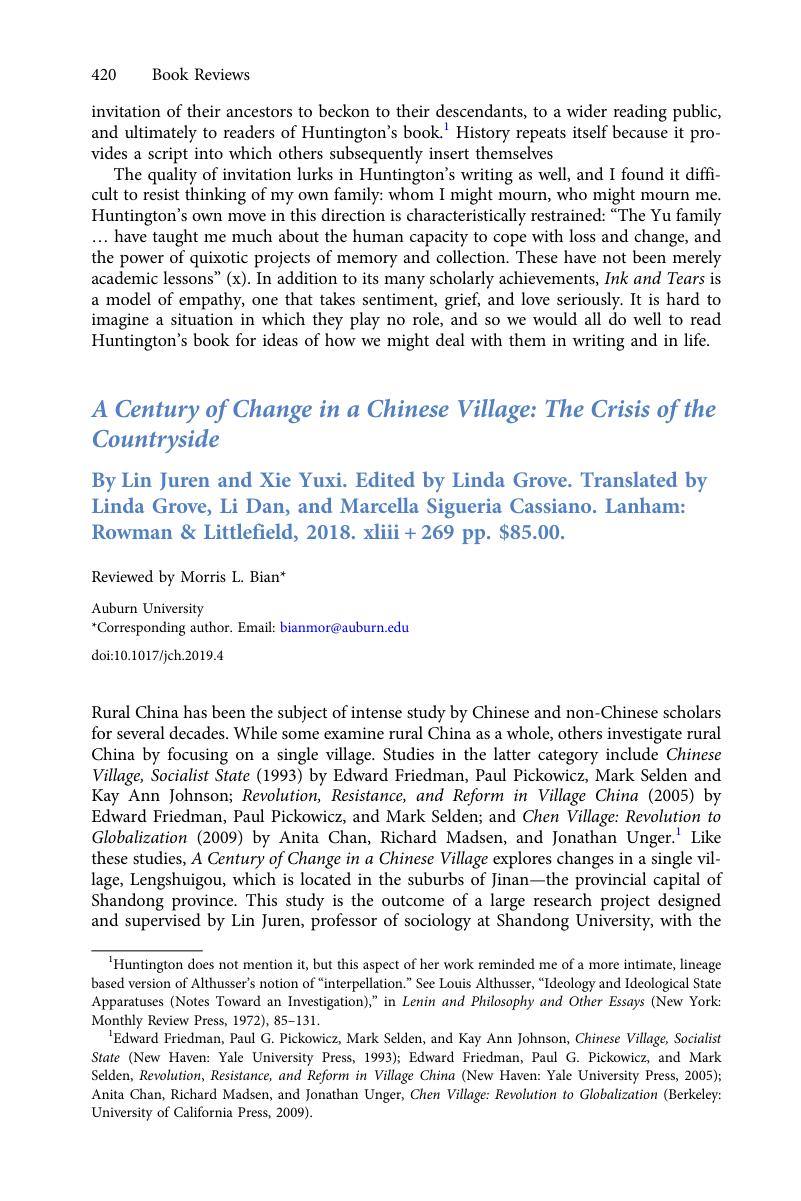No CrossRef data available.
Published online by Cambridge University Press: 20 August 2019

1 Friedman, Edward, Pickowicz, Paul G., Selden, Mark, and Johnson, Kay Ann, Chinese Village, Socialist State (New Haven: Yale University Press, 1993)Google Scholar; Friedman, Edward, Pickowicz, Paul G., and Selden, Mark, Revolution, Resistance, and Reform in Village China (New Haven: Yale University Press, 2005)Google Scholar; Chan, Anita, Madsen, Richard, and Unger, Jonathan, Chen Village: Revolution to Globalization (Berkeley: University of California Press, 2009)Google Scholar.
2 Myers, Ramon, The Chinese Peasant Economy: Agricultural Development in Hopei and Shantung, 1890–1949 (Cambridge, MA: Harvard University Press, 1970)Google Scholar; Huang, Philip C.C., The Peasant Economy and Social Change in North China (Stanford: Stanford University Press, 1985)Google Scholar; Duara, Prasenjit, Culture, Power and the State: Rural North China, 1900–1942 (Stanford: Stanford University Press, 1988)Google Scholar.
3 Bian, Morris L., The Making of the State Enterprise System in Modern China: The Dynamics of Institutional Change (Cambridge, MA: Harvard University Press, 2005), 6–13CrossRefGoogle Scholar.
4 Bian, Morris L., “Redefining the Chinese Revolution: The Transformation and Evolution of Guizhou's Regional State Enterprises, 1937–1957,” Modern China 41.3 (2015): 313–50CrossRefGoogle Scholar.
5 Bian, Morris L., “Explaining the Dynamics of Change: Transformation and Evolution of China's Public Economy through War, Revolution, and Peace, 1928–2008,” in State Capitalism, Institutional Adaptation, and the Chinese Miracle, ed. Naughton, Barry and Tsai, Kellee S. (New York: Cambridge University Press, 2015), 201–22CrossRefGoogle Scholar.
6 Wong, R. Bin, China Transformed: Historical Change and the Limits of European Experience (Ithaca: Cornell University Press, 1997), 69Google Scholar.
7 Pomeranz, Kenneth, The Great Divergence: Europe, China, and the Making of the Modern World Economy (Princeton: Princeton University Press, 2001), 8, 16Google Scholar.
8 Rosenthal, Jean-Laurent and Wong, R. Bin, Before and Beyond Divergence: The Politics of Economic Change in China and Europe (Cambridge, MA: Harvard University Press, 2011), 98CrossRefGoogle Scholar.
9 Huang, Philip C.C., “Development or Involution in Eighteenth-Century Britain and China? A Review of Kenneth Pomeranz's The Great Divergence: China, Europe, and the Making of the Modern World Economy,” Journal of Asian Studies 61(2002): 501–38CrossRefGoogle Scholar.
10 Brenner, Robert and Isett, Christopher, “England's Divergence from China's Yangzi Delta: Property Relations, Microeconomics, and Patterns of Development,” Journal of Asian Studies 61 (2002): 609–62CrossRefGoogle Scholar.
11 I believe that the German historian Jürgen Kocka provides the best definition of the term capitalism. His working definition of capitalism “emphasizes decentralization, commodification, and accumulation as basic characteristics. First, it is essential that individual and collective actors have rights, usually property rights, that enable them to make economic decisions in a relatively autonomous and decentralized way. Second, markets serve as the main mechanisms of allocation and coordination; commodification permeates capitalism in many ways, including labor. Third, capital is central, which means utilizing resources for present investment in expectation of future higher gains, accepting credit in addition to savings and earnings as sources of investment funds, dealing with uncertainty and risk, and maintaining profit and accumulation as goals.” See Kocka, Jürgen, Capitalism: A Short History (Princeton: Princeton University Press, 2016), 21CrossRefGoogle Scholar.